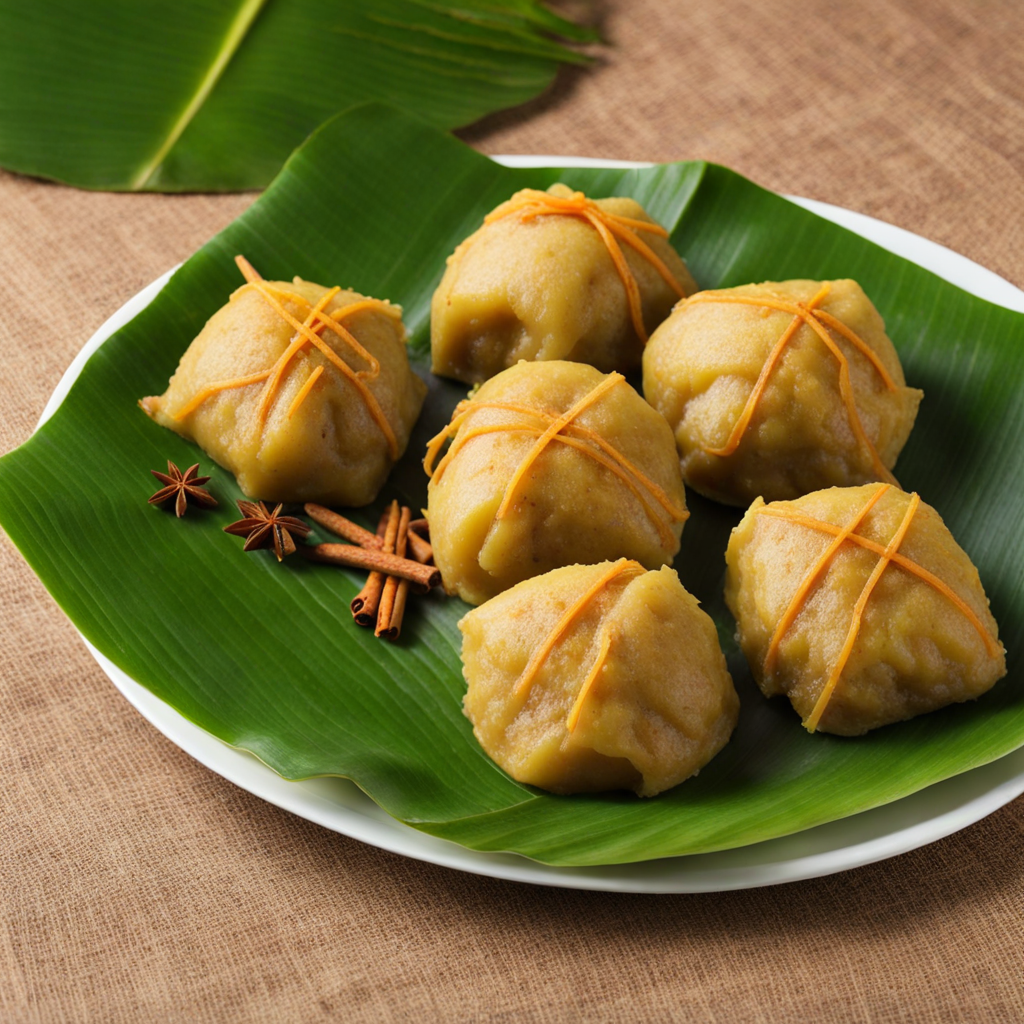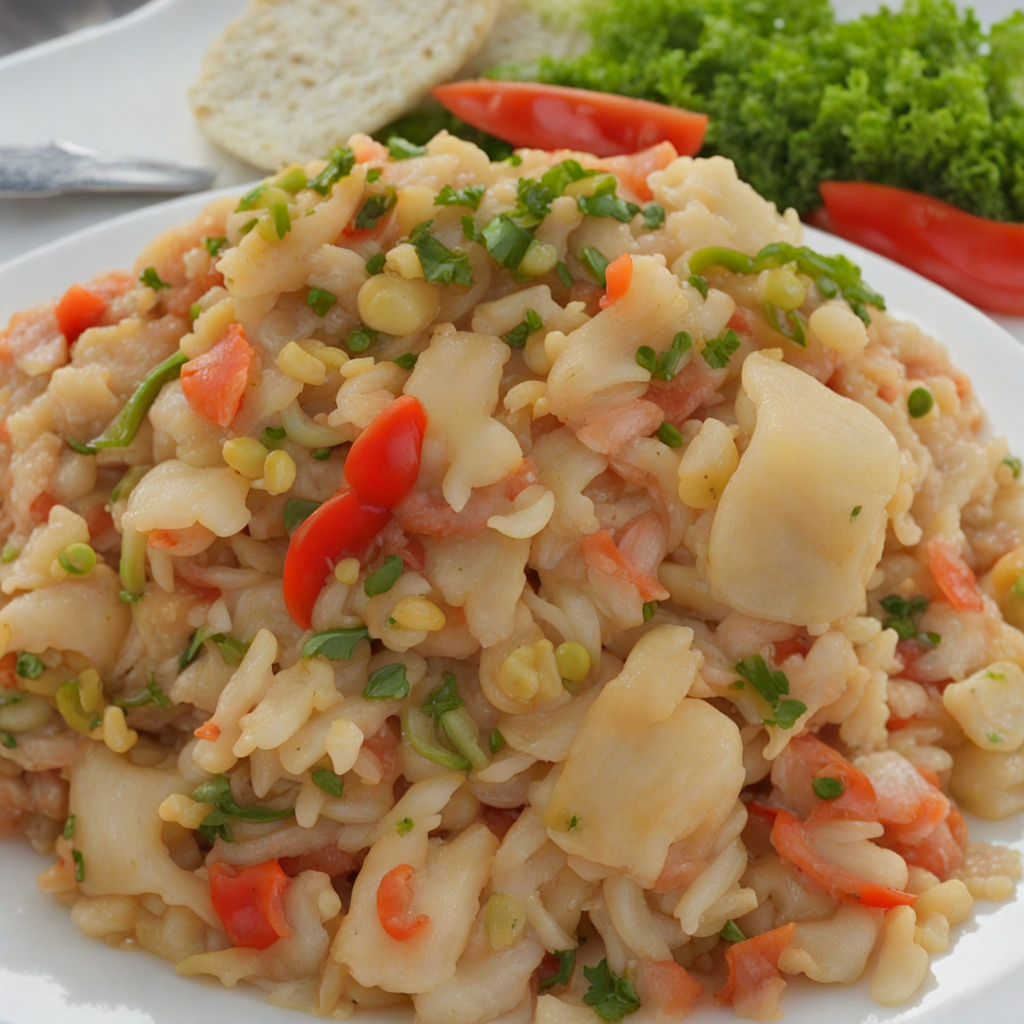Ducana
Ducana is a traditional dish from Dominica, characterized by its unique combination of flavors and textures. This delightful treat is made primarily from grated green bananas, which provide a subtle sweetness and a starchy base. The bananas are mixed with coconut, spices, and often a hint of vanilla, creating a rich and aromatic batter. Wrapped in banana leaves and steamed to perfection, Ducana boasts a soft, moist interior that melts in your mouth, offering a comforting taste of the Caribbean. What sets Ducana apart is its versatility. While the classic version is prepared with coconut and spices, variations can include the addition of sweet potatoes or other root vegetables, enhancing the dish's depth of flavor. The coconut adds a creamy richness, while the spices, such as nutmeg and cinnamon, provide warmth and complexity. Each bite delivers a harmonious blend of sweet and savory notes, making it an intriguing option for adventurous eaters. Often served alongside a savory dish, such as saltfish or a hearty vegetable stew, Ducana serves as a perfect complement, balancing the meal with its subtle sweetness. This dish embodies the essence of Dominican cuisine, which celebrates the use of fresh, local ingredients and traditional cooking methods. For anyone looking to explore new culinary horizons, Ducana offers a delightful journey into the flavors of Dominica, promising an unforgettable experience.
How It Became This Dish
The History of Ducana: A Cultural Staple of Dominica #### Origin and Early History Ducana is a beloved dish from Dominica, a lush and mountainous island in the Caribbean known for its rich cultural tapestry and vibrant culinary heritage. The origins of ducana can be traced back to the indigenous peoples of the Caribbean, particularly the Kalinago (Carib) and Arawak tribes, who primarily inhabited the region long before European colonization. These early inhabitants cultivated cassava, a starchy root vegetable that serves as a central ingredient in many traditional Caribbean dishes. The name 'ducana' is derived from the Arawak word for "dumpling," which aptly describes the dish's structure. Traditionally, ducana is made from grated sweet potatoes or a combination of sweet potatoes and cassava, mixed with flour and spices, then wrapped in banana leaves and boiled. The use of banana leaves reflects the indigenous peoples’ resourcefulness and connection to their natural environment, as they utilized locally available materials for cooking and serving. #### Cultural Significance Ducana holds a special place in Dominican culture, symbolizing not only the island's agrarian roots but also the blending of indigenous, African, and European culinary traditions. Following Christopher Columbus's arrival in the Caribbean in 1492, European colonization brought about significant demographic changes. Enslaved Africans were brought to the island to work on plantations, and their culinary practices began to intermingle with those of the indigenous peoples and European settlers. As a result, ducana evolved to reflect these diverse influences. In particular, the African culinary tradition of using starchy ingredients to create hearty meals is evident in ducana's preparation. The dish is often accompanied by a rich sauce or gravy, usually made from salted fish, which adds depth and reinforces the communal aspect of dining—a practice rooted in both African and Caribbean traditions. In Dominica, ducana is often served during festive occasions and gatherings, notably during the annual Independence Day celebrations on November 3rd. This connection to national pride and cultural identity reinforces the dish's significance, as it serves as a reminder of the island's history and resilience. #### Development Over Time As Dominican society evolved, so too did the preparation and presentation of ducana. While the fundamentals of the dish have remained largely unchanged, variations have emerged that reflect local ingredients and individual preferences. Today, sweet potatoes are the primary base, but some modern recipes incorporate other ingredients, such as coconut milk, to enhance flavor and moisture. Ducana is particularly popular during the Christmas season, when families come together to celebrate with traditional foods. It is often served alongside dishes such as callaloo soup and roasted meats, creating a rich tapestry of flavors that epitomizes the festive spirit. The act of preparing ducana is often a communal affair, with families gathering to grate, mix, and wrap the dumplings, fostering a sense of unity and shared cultural identity. In recent years, the global interest in Caribbean cuisine has led to a resurgence in the popularity of ducana beyond the shores of Dominica. Chefs and food enthusiasts around the world have begun to explore Caribbean flavors, leading to ducana being featured in restaurants and culinary events internationally. This exposure has allowed for a reinterpretation of the dish, with chefs experimenting with fusion techniques and innovative presentations while still honoring its traditional roots. #### Contemporary Innovations Contemporary chefs in Dominica and abroad have embraced ducana, reimagining it for modern palates while keeping its traditional essence intact. For instance, variations may include the addition of spices like nutmeg and cinnamon, or even experimenting with different types of sweet potatoes to explore new flavor profiles. There are also creative presentations, such as serving ducana in a deconstructed style or pairing it with gourmet sauces that reflect global culinary trends. Moreover, the rise of the farm-to-table movement has highlighted the importance of using locally sourced ingredients in the preparation of ducana. Many chefs prioritize sustainability and local agriculture, connecting diners not only to the flavors of the dish but also to the cultural and ecological landscape of Dominica. This emphasis on locality and sustainability is a nod to the island’s bounty and a recognition of the importance of preserving culinary traditions. #### Conclusion Ducana is more than just a dish; it is a symbol of Dominica’s rich heritage, representing the island’s history of resilience, cultural exchange, and community. From its indigenous roots to its modern interpretations, ducana reflects the dynamic nature of Caribbean cuisine and the enduring importance of food as a means of cultural expression. As Dominica continues to navigate the complexities of globalization and cultural exchange, ducana remains a steadfast reminder of the island’s identity and the stories woven into every bite. Whether enjoyed during festive celebrations or as part of everyday meals, ducana invites people to share in the flavors and traditions of a vibrant culture that celebrates its past while looking toward the future.
You may like
Discover local flavors from Dominica







